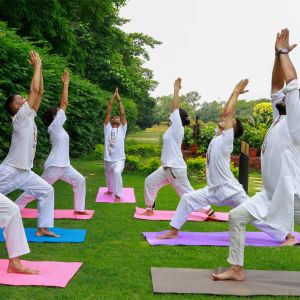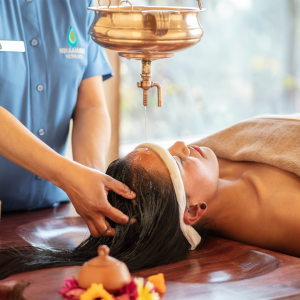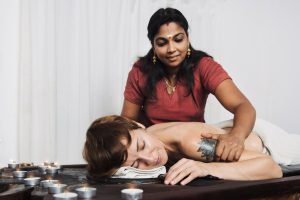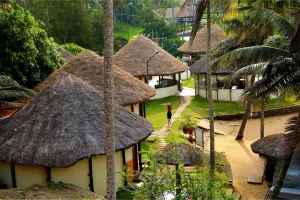The moment I stepped off the plane in Kerala for my first authentic Ayurvedic retreat 20 years ago, I knew I was experiencing something fundamentally different from the Western spa vacations I’d grown accustomed to. That journey sparked a two-decade exploration that would eventually lead me to found MadAboutWellness and personally review over 500 wellness centers across India.
What makes wellness retreats in India so transformative compared to their Western counterparts? Let me take you on a journey through the key differences I’ve discovered as both a wellness advocate and someone who starts each day with yoga.
The Ancient Science vs. Modern Luxury Approach
Western spa vacations often focus on pampering and temporary relaxation. You might enjoy a Swedish massage, a facial, and perhaps a meditation class before returning to your regular life largely unchanged.
In contrast, wellness retreats in India approach healing through ancient systems that view humans as integrated beings:
- Ayurveda: A 5,000-year-old medical system that identifies your unique constitution (dosha) and creates personalized treatments

- Yoga: Not just physical postures, but a complete science of mind-body integration

- Traditional healing practices: Including specific breathwork, sound therapy, and energy medicine

Traditional healing practices
During my recent visit to Ananda in the Himalayas, I watched as a guest with chronic back pain received a treatment plan that included not just massage but dietary changes, specific yoga postures, meditation techniques, and even adjustments to his daily routine. This comprehensive approach simply doesn’t exist in most Western settings.
Practitioners: Certification vs. Lineage

The difference in practitioner expertise might be the most underappreciated factor in this comparison.
At a luxury spa in New York or London, your therapist likely completed a certification program lasting several months to a year. They’ll certainly be professional and well-trained.
But at Kalari Kovilakom, where I stayed last year to document their traditional treatments, I met practitioners whose families have practiced Ayurvedic medicine for seven generations. The lead physician explained:
“My great-grandfather treated the grandfather of some patients who still come here. We understand their constitutions across generations.”
This depth of knowledge creates an entirely different healing experience. It’s the difference between reading about swimming and being taught by someone whose ancestors have navigated the same waters for centuries.
Personalization: Menu Options vs. Complete Systems
Western wellness often offers a menu of isolated treatments from which you choose based on preferences or desired outcomes.
Indian wellness retreats begin with a comprehensive diagnosis. At Soukya International Holistic Health Centre, where I spent a week evaluating their programs, each guest undergoes:
- Detailed health history assessment
- Traditional pulse diagnosis (nadi pariksha)
- Physical examination using Ayurvedic parameters
- Modern diagnostic testing, when appropriate
Only then do practitioners create an integrated treatment plan addressing the root causes of imbalance rather than just symptoms.
“We don’t guess what might help you based on what you think you need,” the wellness director told me. “We determine what will actually restore balance based on understanding your unique constitution.”
Duration: Weekend Escape vs. Healing Journey
Western spa vacations typically last a weekend to a week, with the understanding that you’re taking a brief break from regular life.
Authentic wellness retreats in India recommend minimum stays of 7-21 days. Why? Because genuine healing follows biological timelines that can’t be rushed.
During my evaluation of Vana Wellness Retreat in Dehradun, I interviewed a guest who had arrived with chronic digestive issues. “The first week was just preparation,” she explained. “My body needed to release accumulated toxins before deeper healing could begin. By day 14, I experienced changes I never thought possible.”
This understanding that healing has phases and requires adequate time represents a fundamental difference in approach.
The Environment: Designed for Healing vs. Designed for Comfort
Most Western wellness resorts prioritize luxury amenities and Instagram-worthy settings.

While India’s top retreats offer comparable comfort, they prioritize creating genuinely healing environments.

At SwaSwara in Gokarna, which I reviewed extensively last year, every aspect of the property was designed according to Vastu principles (India’s ancient architectural science):
- Building orientations that optimize energy flow
- Natural materials that support specific healing outcomes
- Strategic use of water elements to create energetic balance
- Proximity to natural power spots that amplify healing
These design principles aren’t arbitrary—they’re based on a sophisticated understanding of how the environment affects physiology.
Beyond Relaxation: Transformation vs. Temporary Relief
Perhaps the most profound difference lies in outcomes. Western spa vacations provide temporary relaxation and rejuvenation. You feel better for a while before returning to baseline.
Wellness retreats in India aim for transformation. At Atmantan Wellness Centre, where I recently completed a 14-day program review, I documented numerous cases of guests experiencing:
- Resolution of chronic health issues that hadn’t responded to conventional treatments
- Significant shifts in mental and emotional patterns
- Acquisition of practices that continue delivering benefits long after departure
One guest I interviewed had suffered from migraines for 12 years despite trying numerous medications. After a 21-day Ayurvedic program, her migraines decreased by 80%, and continued improving after she returned home.
Education Component: Empowerment vs. Service
Western wellness experiences typically position guests as recipients of services provided by experts.
Indian wellness traditions emphasize education and empowerment. At Kairali Ayurvedic Village, which I consider among the most authentic healing centers in Kerala, each guest receives:
- Personalized dietary guidelines based on their constitution
- Daily routine recommendations (dinacharya) for optimal health
- Specific practices to continue at home
- Understanding of the principles behind their treatments
This education component ensures that healing continues indefinitely rather than ending when you check out.
Is an Indian Wellness Retreat Right for You?
After experiencing hundreds of wellness centers across both traditions, I believe Indian retreats offer superior outcomes for:
- Those seeking solutions to chronic health issues
- People interested in prevention and longevity
- Anyone desiring deeper transformation rather than temporary relaxation
- Those willing to engage actively in their healing process
Western spa vacations still excel for:
- Quick relaxation and stress relief
- Luxury pampering experiences
- Those uncomfortable with unfamiliar cultural practices
- Anyone seeking primarily beauty treatments
Your Next Step Toward Authentic Healing
If you’re intrigued by the possibility of experiencing genuine transformation through India’s ancient wellness traditions, I invite you to explore the curated retreats on MadAboutWellness.
Unlike typical travel sites, we provide detailed, first-hand reviews of each property based on my personal visits. You’ll find honest assessments of which centers excel for specific health concerns, what to expect during treatments, and how to prepare for a truly transformative experience.
The journey to authentic healing begins with a single step. Make it a step guided by someone who has walked the path before you.

